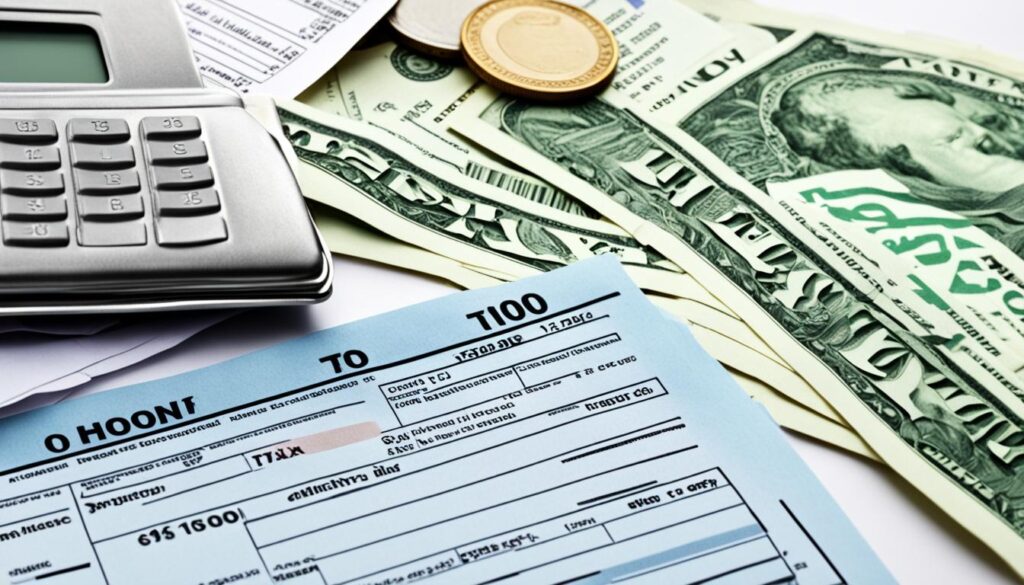In Australia, the tax-free threshold plays a crucial role in determining how much tax individuals need to pay on their income. If you don’t claim the tax-free threshold, you will be subject to higher upfront income tax, potentially resulting in a larger tax bill or a smaller tax refund. It is important to understand the tax implications of not claiming the threshold to avoid any negative financial consequences.
Key Takeaways:
- Not claiming the tax-free threshold in Australia can lead to higher upfront income tax.
- It may result in a larger tax bill or a smaller tax refund.
- Understanding the tax implications of not claiming the tax-free threshold is crucial for financial planning.
- Claiming the tax-free threshold provides individuals with more money in their pockets throughout the year.
- Consulting with a tax professional can help determine the best approach regarding the tax-free threshold.
Understanding the Tax-Free Threshold in Australia
The tax-free threshold is an important concept in the Australian tax system, allowing individuals to earn a certain amount of income each financial year without being liable for tax. Currently, the tax-free threshold is set at $18,200 according to the Australian Taxation Office (ATO).
Claiming the tax-free threshold offers numerous benefits for Australian residents. One of the key advantages is having more money in your pocket throughout the year. By not paying tax on the income within the threshold, you can enjoy a higher take-home pay, providing you with extra financial freedom for day-to-day expenses or savings.
Furthermore, claiming the tax-free threshold ensures that your tax liability is accurately reflected. It helps to prevent an excess amount of tax being withheld from your income, which can occur if you do not claim the threshold. By claiming it, you can avoid the unnecessary overpayment of tax and have a more accurate representation of your payable tax.
Understanding the rules and guidelines surrounding the tax-free threshold is crucial for compliance with the taxation system. It is essential to know the current threshold amount and ensure that you meet the residency requirements to qualify for claiming it. By staying informed and following the regulations, you can maximize the benefits of the tax-free threshold and optimize your financial situation.
As an Australian resident, familiarizing yourself with the importance of claiming the tax-free threshold, the benefits it offers, and the rules governing its eligibility can greatly contribute to your financial well-being.
Consequences of Not Claiming the Tax-Free Threshold
Choosing not to claim the tax-free threshold can have significant consequences on your financial situation. When you decide not to claim this threshold, you are effectively opting to pay tax on your entire earnings, regardless of whether your income falls below the $18,200 threshold. This means that even if you earn a lower income, you will still be subject to income tax.
Some individuals may intentionally choose not to claim the tax-free threshold as a savings strategy. They may opt to pay more in taxes throughout the year with the expectation of receiving a larger tax refund when they file their tax return. However, it is important to consider the impact this decision will have on your take-home pay throughout the year.
By not claiming the tax-free threshold, your employer will withhold a larger amount of tax from each paycheck. This means that you will have less money available to you on a regular basis, potentially impacting your day-to-day expenses and overall financial stability.
It is worth noting that while this strategy may result in a larger tax refund when you file your return, it can lead to financial constraints throughout the year.
“Choosing not to claim the tax-free threshold may result in a larger tax refund at the end of the year, but it can leave you financially worse off throughout the year.” – Australian Taxation Office
To illustrate the potential impact, consider the following scenario:
| Income | Tax Withheld (Claiming Threshold) | Tax Withheld (Not Claiming Threshold) | Difference in Take-Home Pay |
|---|---|---|---|
| $40,000 | $3,572 | $4,422 | $850 |
| $60,000 | $10,097 | $12,272 | $2,175 |
| $80,000 | $17,622 | $21,122 | $3,500 |
Note: The table above demonstrates the difference in take-home pay between claiming and not claiming the tax-free threshold at various income levels.
As seen in the table, the difference in take-home pay can be substantial, particularly for those with higher incomes. By not claiming the tax-free threshold, you may face financial challenges throughout the year, making it harder to meet your expenses and achieve your financial goals.
Plan Your Tax Strategy Carefully
When considering whether to claim the tax-free threshold or not, it’s important to carefully evaluate your financial situation and goals. While claiming the threshold may result in a smaller tax refund, it ensures that you have more money available to you throughout the year, enabling better financial management and flexibility.
Consulting with a tax professional can provide valuable insights and advice tailored to your specific circumstances. They can help you navigate the complexities of the tax system and make informed decisions to optimize your tax position without sacrificing your financial well-being.
Pros of Claiming the Tax-Free Threshold
Claiming the tax-free threshold offers several benefits for individuals in Australia. By understanding and utilizing this tax provision, you can enjoy the following advantages:
1. More Money in Your Pocket Throughout the Tax Year
Claiming the tax-free threshold means that less tax will be withheld from each paycheck. This results in a higher take-home pay throughout the year, allowing you to have more funds available for your everyday expenses, savings, or investments.
2. Accurate Reflection of Your Tax Liabilities
By claiming the tax-free threshold, your taxable income will be appropriately adjusted, ensuring that the amount of tax you need to pay is correctly calculated. This enables you to have a better estimation of your tax liabilities and ensures compliance with tax regulations.
3. No Tax Owed if Your Income is Below the Threshold
If your annual income is below the tax-free threshold ($18,200), claiming this benefit can lead to no tax being owed for the financial year. This is especially advantageous for individuals with lower incomes as it relieves them from the burden of paying taxes.
4. Higher Take-Home Pay and Reduced Tax Bills
Claiming the tax-free threshold not only increases your current take-home pay, but it also reduces the likelihood of a tax bill at the end of the financial year. As less tax is withheld from your income, you can enjoy a higher net income and avoid the stress of unexpected tax payments when filing your tax return.
| Pros of Claiming the Tax-Free Threshold |
|---|
| More money in your pocket throughout the tax year |
| Accurate reflection of your tax liabilities |
| No tax owed if your income is below the threshold |
| Higher take-home pay and reduced tax bills |
By understanding the benefits of claiming the tax-free threshold, you can optimize your financial situation, have more control over your income, and experience greater financial stability throughout the year.
Cons of Claiming the Tax-Free Threshold
While there are benefits to claiming the tax-free threshold, it’s important to consider the potential drawbacks. One of the main concerns is that by claiming the tax-free threshold, you may receive a smaller tax refund. This is because less tax will be withheld from each paycheck throughout the year, resulting in a reduced refund amount when you file your tax return.
Additionally, if too little tax is taken out each pay cycle because you’ve claimed the tax-free threshold, you may end up owing taxes when you lodge your tax return. This can come as a surprise if you haven’t set aside enough money to cover the tax liability.
It’s crucial to carefully evaluate your financial situation and consult with a tax professional or advisor before deciding to claim the tax-free threshold. They can provide personalized advice based on your circumstances and help you determine if claiming the threshold is the best option for you.
Considerations When Claiming the Tax-Free Threshold:
- Review your financial goals: Understand how claiming the tax-free threshold aligns with your financial objectives and long-term plans.
- Evaluate current income and expenses: Analyze your income streams and monthly expenses to ensure that claiming the threshold won’t put you in a precarious financial situation.
- Plan for potential tax liabilities: Take into account any potential tax liabilities that may arise if you claim the tax-free threshold and set aside funds to cover these obligations.
- Understand the impact on your cash flow: Recognize that by claiming the threshold, you’ll have more money in your pocket throughout the year, but it may result in a smaller tax refund, impacting your cash flow.
Remember, every individual’s financial circumstances are unique, and what works for one person may not work for another. Seeking professional advice will ensure that you make informed decisions that align with your specific financial needs and goals.

Multiple Jobs and the Tax-Free Threshold
If you have multiple jobs or receive a taxable pension or government allowance in addition to a regular part-time job, it is important to understand the claiming tax-free threshold process. To ensure you don’t end up owing a large tax bill at the end of the financial year, the Australian Taxation Office advises individuals to only claim the tax-free threshold on the job that pays them the most annually.
By following this advice, you can optimize your tax situation and reduce the chances of overpaying or underpaying tax. It’s crucial to accurately assess which job provides you with the highest annual income, as only that job should have the tax-free threshold claimed. This strategy will help you avoid unexpected financial burdens and ensure that you’re taking full advantage of the tax benefits available to you.
By understanding and correctly implementing the claiming tax-free threshold process when you have multiple jobs or additional sources of income, you can maintain a more efficient and manageable tax situation. This approach will contribute to your overall financial well-being and help you avoid any potential complications in reconciling your taxes at the end of the financial year.
Adjusting the Tax-Free Threshold for New Residents
New residents to Australia may still be eligible to claim an adjusted tax-free threshold. If you became an Australian resident partway through the year, you may qualify for a reduced tax-free threshold based on the number of months you were a resident. It is important to understand the process of claiming the tax-free threshold as a new resident and how it can benefit your tax situation.
When you become a new resident in Australia, you can claim an adjusted tax-free threshold that takes into account the number of months you have been residing in the country. This means that if you arrived in Australia halfway through the financial year, your tax-free threshold will be reduced based on the months you were not considered a resident.
For example, if you arrived in Australia in January and the financial year ends in June, you would be considered a resident for six out of twelve months. In this case, you would be eligible for half of the tax-free threshold amount.
Claiming the adjusted tax-free threshold as a new resident can have several benefits. By taking into account the time you have been living in Australia, you can ensure that your tax obligations are fair and reflect your actual income. This can result in a lower tax liability for the portion of the year you were not considered a resident.
It is important to note that the process of claiming the adjusted tax-free threshold may vary depending on your circumstances. You may need to provide documentation or evidence of your residency status to the Australian Taxation Office (ATO) when submitting your tax return.
To ensure that you claim the adjusted tax-free threshold correctly, it is recommended to seek assistance from a tax professional or refer to the ATO’s guidelines and resources. They can provide you with the necessary information and help you navigate the process successfully.
Example: Adjusted Tax-Free Threshold Calculation
| Fiscal Year | Residency Status | Adjusted Tax-Free Threshold |
|---|---|---|
| 2022-2023 | New resident from January | $9,100 (half of $18,200) |
| 2022-2023 | New resident from July | $18,200 (full tax-free threshold) |
In the above example, a new resident who arrived in Australia in January of the 2022-2023 financial year would be eligible for an adjusted tax-free threshold of $9,100. This means that they would only need to pay tax on the portion of their income that exceeds $9,100 for the months they were a resident.
How to Claim the Tax-Free Threshold
Claiming the tax-free threshold is a simple process that can help increase your take-home pay. Whether you’re starting a new job or receiving a Centrelink payment, you will be given a Tax File Number Declaration form to fill out. On this form, you will find a question asking if you want to claim the tax-free threshold. To claim the threshold, all you need to do is answer “yes” to this question.
By claiming the tax-free threshold, you are instructing your employer or Centrelink to withhold less tax from each paycheck. This means that more money will be available to you throughout the year, resulting in a higher take-home pay.
It’s important to keep in mind that claiming the tax-free threshold is only applicable if you meet the eligibility criteria. As an Australian resident, you are entitled to the tax-free threshold if your total income during the financial year is below the threshold amount. Currently, the tax-free threshold is set at $18,200 according to the Australian Taxation Office (ATO).
Once you have claimed the tax-free threshold, your employer or Centrelink will adjust the amount of tax withheld from your paycheck accordingly. This will provide you with a more accurate reflection of the tax you need to pay, ultimately reducing the likelihood of owing taxes at the end of the financial year.
Benefits of Claiming the Tax-Free Threshold
Claiming the tax-free threshold offers several advantages. By having less tax withheld from each paycheck, you will have more money at your disposal throughout the year. This can help with managing your expenses, saving for the future, or simply enjoying a higher disposable income.
Additionally, claiming the tax-free threshold can eliminate the need to pay taxes if your income is below the threshold amount. This means that if you earn less than $18,200 in a financial year, you will not be required to pay income tax, providing you with additional financial relief.
Furthermore, claiming the tax-free threshold can simplify your tax affairs. With less tax being withheld from each paycheck, you may not owe any taxes at the end of the year, reducing the administrative burden of filing a tax return.
Overall, claiming the tax-free threshold is a straightforward process that can have significant financial benefits. By properly completing the Tax File Number Declaration form and indicating your intention to claim the tax-free threshold, you can enjoy a higher take-home pay and potentially reduce your tax liabilities.
| Tax-Free Threshold | Benefits |
|---|---|
| Increased take-home pay | More money available throughout the year |
| Potential tax savings | No taxes owed if income is below the threshold |
| Simplified tax affairs | Less administrative burden at tax time |
Non-Lodgement Advice and the Tax-Free Threshold
If your income is below the tax-free threshold and you are not required to lodge a tax return, it is important to submit a Non-Lodgement Advice to the Australian Taxation Office. This step informs the ATO that you do not need to lodge a return for that particular financial year. Failing to submit the Non-Lodgement Advice can result in penalties or fines, so it is crucial to understand the requirements and follow the necessary steps to remain compliant with the taxation system.

“By submitting the Non-Lodgement Advice, you are fulfilling your obligation to communicate your non-lodgement status to the ATO. This ensures that your tax affairs are appropriately recorded and that you are not liable for penalties or fines related to non-compliance.”
To submit the Non-Lodgement Advice, you can do so online through the ATO’s official website. The process is straightforward and can be completed in just a few simple steps. By providing the necessary information and confirming your non-lodgement status, you are taking the necessary actions to avoid any potential consequences of not claiming the tax-free threshold.
| Steps to Submit Non-Lodgement Advice: |
|---|
| 1. Log in to your ATO online account. |
| 2. Access the “Lodgements” section. |
| 3. Select “Non-Lodgement Advice” from the available options. |
| 4. Provide the requested information, including your personal details and the reason for non-lodgement. |
| 5. Submit the Non-Lodgement Advice. |
By following these steps and submitting the Non-Lodgement Advice, you are fulfilling your obligations as a taxpayer, even if you are not required to lodge a tax return. This ensures that your non-lodgement status is acknowledged by the ATO, mitigating the risk of penalties or fines.
Conclusion
Understanding and properly claiming the tax-free threshold is crucial for individuals in Australia. Failing to claim the threshold can have significant tax implications, including higher upfront taxes and potential financial drawbacks. By availing the tax-free threshold, individuals can maximize their take-home pay, ensure accurate tax calculations, and potentially receive a larger tax refund. It is essential to consult with a tax professional or utilize online resources to fully comprehend the rules and benefits of claiming the tax-free threshold.
